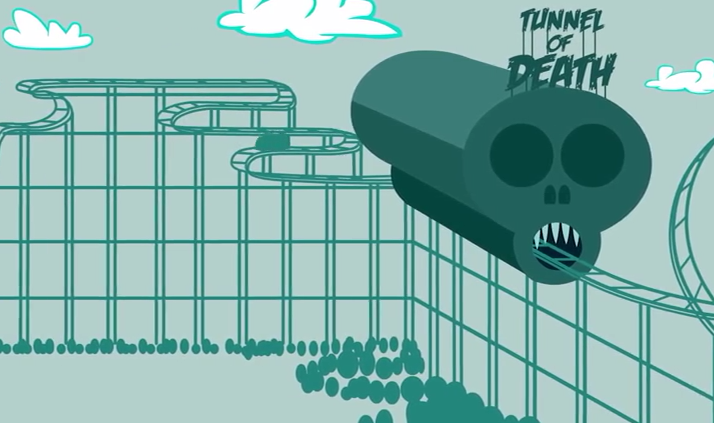Somewhere right now, people are lining up to scare themselves, maybe with a thrill ride or horror movie.
此时此刻,世界上的某个地方,人们正排着队的体验恐惧或许是刺激的游乐设施,或许是恐怖电影。
In fact, in October of 2015 alone, about 28 million people visited a haunted house in the U.S.
事实上,仅仅2015年10月这一个月期间,美国就有近2800万人次选择到鬼屋寻求刺激。
But many consider this behavior perplexing, asking the question, "What could possibly be fun about being scared?"
很多人认为这种寻求刺激惊吓的行为令人费解,他们提出了这样的问题:“感受恐惧,寻求刺激有那么好玩么?”
Fear has a bad rap, but it's not all bad.
诚然,“恐惧”这个词名声不佳,但也并非全无是处。

For starters, fear can actually feel pretty good.
对于新人而言,恐惧确实是个有趣的东西。
When a threat triggers our fight or flight response, our bodies prepare for danger by releasing chemicals that change how our brains and bodies function.
当刺激活动引发了我们类似搏斗或飞行的反应时,我们的身体就会释放激素,改变大脑和身体的机能,以此来应对即将到来的危险或者说“恐惧"。
This automatic response jumpstarts systems that can aid in survival.
这套自发的快速反应系统能够帮助我们更好的生存。
They do this by making sure we have enough energy and are protected from feeling pain,
它通过关闭某些不必要的系统,如批判性思维等来确保我们有充足的能量,
while shutting down nonessential systems, like critical thought.
从而保护我们,减轻或免除我们的疼痛。
Feeling pain-free and energized, while not getting caught up in worrisome thoughts that normally occupy our brains, that all sounds great,
想想吧,当我们充分感受着恐惧或痛苦,大脑中却未充斥着真正身处致命危机时的忧患思绪,这是多么爽的感受啊。
and it can be because this response is similar, though not exactly the same to what we experience in positive, high-arousal states,
而这是可行的,因为恐惧刺激产生的情绪和感受同那些常见的正向高唤醒情绪的反应大同小异,
like excitement, happiness, and even during sex.
比如激动、高兴甚至性行为。
The difference lays in the context.
他们的区别就在于处境不同。
If we're in real danger, we're focused on survival, not fun.
当真正身处险境时,我们更多关注的是如何生存而非享受恐惧。
But when we trigger this high arousal response in a safe place, we can switch over to enjoying the natural high of being scared.
但是当我们在安全的环境中尝试这种高唤醒情绪时就能够全身心的去感受这种恐惧带来的纯天然“高潮”。
It's why people on roller coasters can go from screaming to laughing within moments.
这就是为什么人们在乘坐过山车时能够在瞬息间完成尖叫和大笑的转变。
Your body is already in a euphoric state. You're just relabeling the experience.
我们的身体其实早已处于愉悦状态了。我们只是在自我催眠,好像自己真的身处险境一样。
And though the threat response is universal,
研究表明,虽然这种这种“恐惧愉悦”现象十分普遍,
research shows differences between individuals in how the chemicals associated with the threat response work.
却仍会因个体的不同体现出些许差异。这种区别体现在激素刺激产生愉悦感的过程中。
This explains why some are more prone to thrill-seeking than others.
这就解释了为什么有些人更热衷于去寻求刺激,感受恐惧。


